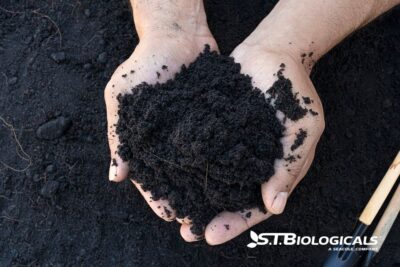Weed management is a major issue with alfalfa in both conventional and regenerative fields. But it doesn’t have to be. With planning and proper timing, you can have a strong stand of alfalfa that outcompetes the weeds. Alfalfa is a high-performance crop. It rewards attention, but it doesn’t handle neglect well.
With a little extra care, your alfalfa can be the most nutritious for your livestock and fetch the highest market prices. We will focus on no-till and regenerative agriculture practices because they require more precision than simply spraying a pre-emergent herbicide.
First Things to Consider with Alfalfa
It matters what crop you planted the year before planting alfalfa. If you planted wheat or another small grain the year before, leave the crop residue intact to reduce erosion and retain moisture.
But if you planted corn or soybeans in the field planned for alfalfa this year, another step is required for a good stand of alfalfa. The crop residue from corn or soybeans has to be spread evenly so it doesn’t block the seed-to-soil contact of your alfalfa. One way to accomplish this is by adding biostimulants or fungal inoculants to accelerate the breakdown of that crop residue.
Trichoderma or Bacillus strains not only decompose the previous crop residue, but they also add microbial diversity to your no-till fields. That‘s beneficial for the nutrient content of the alfalfa. Corn and soybean residue contain nitrogen, phosphorus, and potassium, which also benefit your alfalfa if properly managed.
Alfalfa is fussy about soil pH. It likes to live in soil that’s 6.5 to 7.5. Acidic soil will ruin your crop. We don’t usually think of alfalfa as a heavy feeder (like corn and its nitrogen requirements) because it’s a legume and fixes nitrogen. But it does have high demands for phosphorus, potassium, sulfur, calcium, and micronutrients. After all, it is a major feedstock for animals that need a balanced diet to be productive. It’s important to get your soil tested for those micronutrients. Adding organic amendments such as manure (well-composted to kill weed seeds) can help balance nutrient availability and improve microbial activity.
Now About Those Weeds: Weed Control for Alfalfa
Before you do any planting, find out what weeds are in your field. If you have a heavy infestation of perennial broadleaf weeds you may want to reconsider planting alfalfa. Major weed competition when you’re establishing your alfalfa stand will decrease the quality and crop yield throughout the life of the stand.
It matters what you do at the very beginning of the season. Weed populations tell you a great deal about your soil. Get to know the soil conditions that favor certain weeds, and you’ll be able to control the soil to favor your crops.
A noxious weed infestation puts pressure on your crop yield, and it will impact your ability to sell it as fodder if it’s a poisonous weed.
Soil tests that include micronutrient levels will set you up for a profitable hay season. Healthy soil grows healthy alfalfa. And healthy alfalfa is the best weed and pest competitor.
In a no-till system, you have to plant alfalfa more densely to account for any non-optimal seed-to-soil contact. Using a double-disc opener drill helps plant alfalfa into heavy residue without excessive soil disturbance. You will have to up the seeding rate to 20 to 25 lbs per acre.
Planting a companion crop such as oats or wheat is also a good strategy. They act as nurse crops to suppress weeds and reduce competition. The first cutting of your alfalfa may be primarily grasses, but all subsequent cuttings will be lush alfalfa with very little weed contamination.
An early mowing at about 6 to 8 inches after emergence helps manage weeds organically. You have to time this before the alfalfa has reached that height, but any weeds or other plants competing with the alfalfa will be topped.
Alfalfa as a Seedling Stand and Long Established Field
You know these are radically different ball games. Alfalfa does great for about three years, then yield and quality begin to deteriorate. What is your plan for the next five years?
If you’ve managed well, the first two years of an alfalfa field will give you excellent quality and yield (assuming the weather cooperates and there’s no drought). But rodents, tough winters, and heat stress all go toward weakening the stand, and weed control becomes more difficult.
Short cutting intervals reduce alfalfa vigor and encourage weed growth. It’s a balancing act between producing the highest quality hay and maintaining a strong stand of alfalfa. Longer schedules, where you let the alfalfa reach about 60 percent of regrowth, keep it vigorous and able to outcompete the weeds.
Different techniques can extend your alfalfa field, but not indefinitely. Overseeding with grasses, such as annual rye, triticale, wheat, or barley, creates a different forage product. When you’re considering overseeding, also consider if there’s a market for that forage mixture.
Using clover for overseeding creates a higher protein forage, which is good for dairy cattle. It must be cut at the right time, before flowering, or you’ll lose that protein edge.
Another option is to rotate out of alfalfa for a few years. When the weeds are too difficult to control, you aren’t making any money, and it’s time to fold. Whatever crop you plant into that no-till alfalfa field will have advantages over a tilled field. For a number of years, you’ve been building up the soil microbial populations that work for free, cycling nutrients in the soil. You’ve also retained all your topsoil because you avoided erosion.
Alfalfa is a great cash crop, and even after it’s no longer generating revenue, the practices you put into place on the field are regenerating your soil. Farming is like a long-term chess game. You always have to be thinking 3 to 5 moves (growing seasons) ahead. That low-performing alfalfa field can be the base for your next high-performing row crop.
Work with an ST Biologicals mentor to learn how to extend your alfalfa harvest years with mixed forage silage or grazing cattle and sheep. We help farmers transition from conventional to regenerative agriculture systems and remain profitable. We’re here to help you succeed. When soil speaks, we listen.

